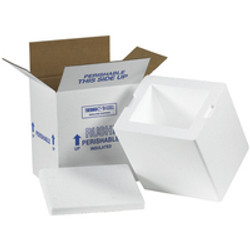
How to Properly Package and Ship Perishables
Receiving a box filled to homemade goodies is always appreciated; not so much if it arrives soggy and spoiled. To ensure that perishables like meat, seafood, fruits, dairy, plants, medications and more arrive safely to their destination, they need to be properly packaged, retaining a consistent temperature of under 40 degrees F. In addition, when you actually ship your perishables also comes into play. I know the process sounds complicated, but with the right shipping products and careful packaging your food items will arrive at their destination, at the appropriate temperature, safe and sound, regardless of the harsh weather conditions they're subjected to.
Following are a few recommended perishable shipping tips.
Insulated Shipping Containers and Supplies
Insulated shipping products minimize the transfer of heat through shipping container walls. The most common insulated shipping materials include rigid polyurethane and expanded polystyrene (EPS) foam as well as and reflective materials. When you combine the appropriate combination of insulation and refrigerants, your perishables will maintain the specified temperature ranges.
Insulated Shipping Containers
You'll be surprised by how affordable these containers are and they're also reusable, lightweight and recyclable. Insulated containers (with a corrugated outer carton) are constructed with thick molded foam that protects the contents from being crushed and include all the important shipping instructions, printed on the outside of the box.
Insulated Box Liners
With leak resistant, insulated box liner's you can come up with your own insulated shipping container when you use them along with cold packs. If you go this route you'll want to be sure to pack everything in a sturdy box.
Cool Shield Bubble Rolls
This perishable shipping product can be used to form tailor made thermal packaging sizes, creating a barrier against moisture, odors and vapor, provides an efficient cushioning and prevents heat transfer through radiation.
Cold Packs
These are very economical to use, leak proof and also reusable. Cold packs will keep perishables at a constant and advisable temperature for days, extend shipping times and stay colder than ice.
Moisture Safe Film Pouches
Moisture Safe film pouches are often used during humid conditions because they help reduce condensation. Made of a non-woven polyethylene material, these ensure exceptional protection, strength, are flexible and puncture resistant.
Dry Ice
Some people use dry ice to ship their perishables however, it is considered a dangerous shipping material for air transport and will require special handling. Whenever possible, opt for the products mentioned above instead.
Know the Shipping Laws
Before you invest time and money packing and shipping your perishables, make sure to find out about any laws that pertain to the destination you're sending your perishables to. How disappointing would it be to ship a box of food items to a country that has quarantine laws that will result in your goods being tossed out?
Scheduling
Plan on mailing your refrigerated or frozen perishables early in the week; if you mail them on a Thursday or Friday you'll be increasing the chance of your package sitting in a hot warehouse all weekend.
You can easily keep your perishable items, whether you want to keep them frozen or prevent them from freezing, and minimize the effects of brief temperature variations, with the proper insulated shipping containers and supplies.

